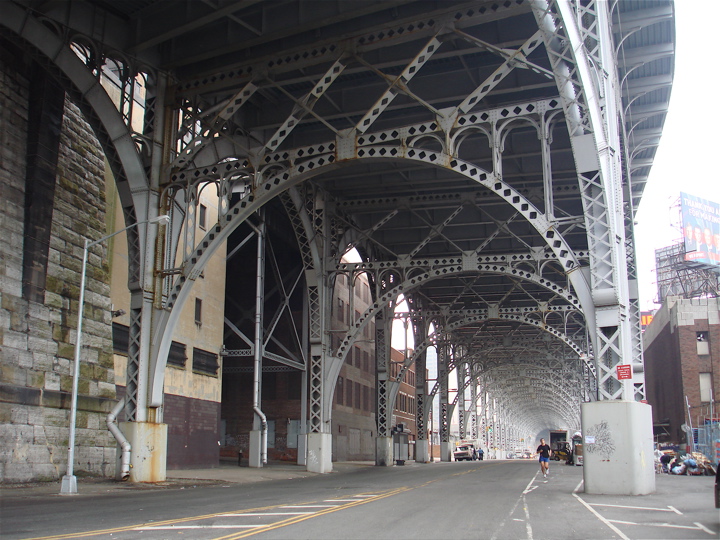Stop, Frisk and Gentrify
By now, most New Yorkers know that the Stop-&-Frisk crime prevention program was only successful for intimidating, humiliating, and violently interrupting the lives of people of color. The threat of jail, court dates and fees, prison, and even death were never far; innocent New Yorkers were stopped over 4 million times--almost 90 percent of them black and Latino. Tens of thousands of New Yorkers marched, researched, litigated, and organized against Stop-&-Frisk.
Understandably, this daily NYPD practice (and racist policing in general) contributes heavily to the expulsion of black and brown people and to gentrification.
Black and brown mothers and fathers in Harlem, Bed-Stuy, the Bronx, and other communities face the unconscionable choice of either leaving their neighborhood (and often, their city) or staying in their home and living in constant fear that their sons and daughters will be harassed, viciously beaten, or even killed by those paid to protect and serve. Many choose to leave.
Gentrification isn’t just about some people choosing to leave and others choosing to move in, it’s about the social forces that restrict people’s choices, which result in pushing out the poor to make way for money.
Ray Kelly recently defended Stop-&-Frisk at a Harlem Week event at Columbia, saying that neighborhoods like Harlem have grown because they’ve become safer. Harlem’s population has grown, but at the same time that 9,000 white folks moved-in (a 400 percent increase), 9,500 black folks moved out. More Hispanics moved to Harlem as well, and of course, some black folks moved in and some white folks moved out, but the big picture is a Harlem that is bleeding Harlemites who grew up there, and is getting a transfusion of wealthier and whiter residents.
Because Harlem isn’t becoming safer for black Harlemites. The combination of rising prices in Harlem, plummeting job opportunities, and wages for black and brown people, and a Stop-&-Frisk society – where if you’re black or brown, you can be stopped even if you’re as young as 11 years old, you can have a gun pointed at your head for no reason, and if you ask why you’re being stopped you can be called a nigger and have your head slammed into a wall (all this by the people who are supposed to protect you?) – it’s no wonder that thousands would leave.
And it’s not just the East Coast. San Francisco mayor Ed Le – a Democrat – flirted with bringing Stop-&-Frisk to the bay, a move that would support the ongoing gentrification and real estate boom in SF. Since the dot-com boom in the ‘90s, the African-American population in San Francisco has dropped 50 percent. But it doesn’t have to be called Stop & Frisk to be racist policing and compel blacks to move to another city. A report published earlier this year investigated the already incredibly racist policing in the bay, where SFPD murdered 19 year old Kenneth Harding Jr. in a hail of bullets – for running away from police after allegedly not producing proof of payment for a two dollar transit train fare.
Thankfully, opposition from citizens and politicians to Lee’s Stop-&-Frisk plan exploded and forced Lee to shift course. Similarly, the massive outrage and organizing against Stop-&-Frisk in New York not only added weight to San Francisco citizens’ outcry, but also led to the 34 percent decrease in Stop-&-Frisks in New York City this year, the first decrease in five years.
In Harlem, Columbia students have even more ability to contribute to positive change and have a greater responsibility to do so, especially as more and more Columbia undergraduates and graduates move to Harlem – of course Morningside Heights used to be (and technically is still considered by some to be) part of Harlem, but many (if not most) people now consider it to be in the Upper West Side.
What can we do? We can fight gentrification, Stop-&-Frisk, and crime all at once. It’s not about not moving to Harlem. If a Columbia student can’t afford the Upper West Side, it’s not their fault that their best option may be Harlem. Gentrification is about the social forces that restrict and compel people’s choices, so we need social solutions.
All Columbia students, faculty and staff, whether we live in Harlem or not, can and should use our power to make Columbia administrators invest Columbia’s resources in what we believe in, and if we believe in living in a community and a city that isn’t segregated by race or income, we have the power to win major victories, not for Harlemites, but with Harlemites, for all of us.
We can hold Columbia administrators accountable to their Manhattanville expansion promises of 5,000 good jobs for Harlemites. We can build more community relationships among students and Harlemites through projects like Grant Gardens, a vegetable garden at the Grant Houses created by residents and students. And we can organize to make Columbia preserve affordable housing throughout Harlem even as the campus expands--right now, Columbia has only earmarked $20 million for affordable housing, while Columbia spent $23 million to renovate the president’s mansion before President Bollinger moved in in 2004. It’s time to change those priorities.
Caring communities, affordable housing, good jobs, educational opportunities – this is what actually reduces crime.


